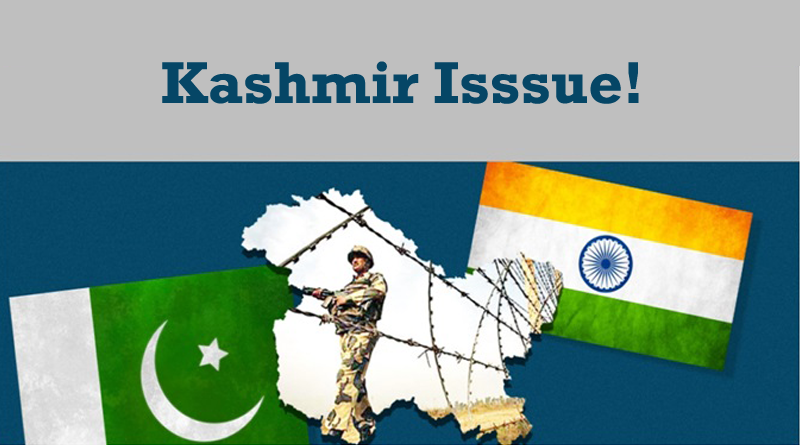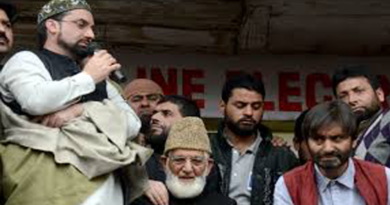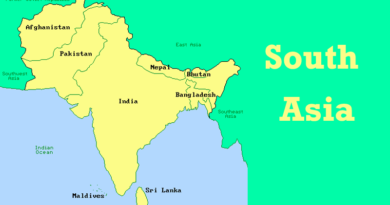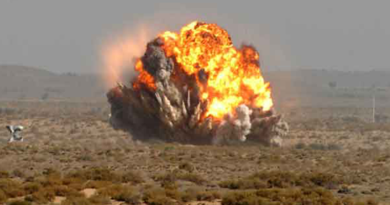What Really is the Kashmir Issue?
The paper aims at bringing clarity to our understanding of the Kashmir issue. The thrust is not on how to present or formulate the issue, but rather how to understand it.
What is Kashmir issue? A lot of confusion surrounds this basic question. Quite often, we come across the statements that Kashmir problem is not a border dispute between two states, it is the question of the basic right of self-determination of seventeen million Kashmiri people. This statement typifies the confusion: it states the fact, while betraying the truth in a very fundamental sense. Mere self-determination is not what Kashmir issue is all about; it may find expression in those words, but in meaning and essence there is something deeper and more profound to it. Even a superficial reading of the above statement will expose its factual incorrectness: for India and Pakistan, Kashmir issue at this point in time, is very much, a question of their national geographical boundaries. The factual incorrectness, however, is a less serious matter than what the mind-set behind such statements intends to achieve. The intended goal is decontexualisation of the Kashmir issue, and that is a serious matter because, once you deprive Kashmir issue (or for that matter any historical issue) of its legitimate context, it is reduced to nothingness. Every historical issue should be traceable to its historical origins and an identifiable process through which this issue has evolved and matured. That gives the issue its rightful context, and it is only when viewed in that context that the issue gets its meaning and substance.
The Historical Context: As will emerge from the discussion that follows, it is a particular historical context, a brief discussion of which will follow shortly, that alone lends Kashmir issue the profundity it really has, even makes it understandable as an issue of self-determination, which apparently it is (wherever I use the phrase ‘self-determination’, I use it in the sense of political self-determination—-choosing one’s political destiny). Detached from that context one even fails to understand, even if conceded for a moment that Kashmir issue is nothing but an issue of self-determination, as to why and how did the ‘original’ Kashmiri political agenda of nineteen twenties evolve into one dominated by the demand of self-determination.
Self-Determination not Rooted in Kashmir’s Original Political Agenda: Let us go back to the earliest days of organized political activity in Kashmir, that is the nineteen twenties. The demands on the political agenda then ranged from freedom of speech to that of assembly. With the advent of late Sheikh Mohammad Abdullah on the political horizon of Kashmir in thirties, the agenda evolved further, taking into its fold, demands like representative government, and ultimately the demand of ‘Quit Kashmir’. At this point in time, Kashmir was an independent and sovereign entity ruled by Dogras, a non-Muslim dynasty from Udhampur in Jammu region, albeit of course, with overriding British sovereignty. For the sake of argument, let us be hypothetical for a moment, and ignore what was happening around this time and soon after in the British Indian subcontinent. That means we will ignore the emergence of India and Pakistan as two sovereign domains, and the ideological-political context surrounding that emergence. Now let us visualize, how the movement in Kashmir would have evolved over the time. It had taken up the question of representative government as we noted above; absorbing more modern thoughts, it would have included the establishment of a democratic government, universal franchise, and a fair distribution of power to all the regions of Kashmir. Some more items might have been added up to the political agenda. Which items, one cannot say with certainty; however, and that is the point I wish to make, what is very much certain is that self-determination would have not been one of these items. The reason is clear: what would have motivated the inclusion of this demand? After all demanding political self-determination is not deciding to set on a long drive, it is not a pleasure, a luxury one would indulge into. It exacts a huge price, and only compelling circumstances justify the inclusion of this demand in a political agenda. There were no such reasons in Kashmir. It was not an occupied land; Dogras who ruled it were sons of the soil. Therefore, self-determination to determine what? The Dogra monarchy would have, over a period of time, given way to a democratic dispensation. So why this demand would have cropped up in the first place? However, the things as we see them now, are entirely different: self-determination is not only on Kashmir’s political agenda, it is at the heart of it, actually the whole agenda is about the very issue of self-determination, and not just today, but has been so for the past 57 years. Is it really the movement of thirties that has so evolved? After all, realities, whether physical or social, do not evolve haphazardly; their evolution follows a definite logic. If a movement graduates from the demand of freedom of speech to that of a representative government, that is a case of natural maturity, a clear evolutionary pattern is visible there, but if it turns to self-determination, that defies logic. One is left with no option but to look for a very strong, an overwhelming external influence, a powerful stimulus, that could be the creative factor behind this unexpected change. So let us look for that, and an important clue here is that the demands of self-determination are often triggered by a change in the geo-political environment.
External Stimulus changes the Political Agenda in Kashmir: When we come out of the hypothetical scenario, and look at the whole world of events and happenings in and around the geo-political environment of Kashmir, one huge historical fact that strikes our eye is the emergence of hitherto non-existent nation- state of India in 1947, and its occupation of Kashmir. In a moment we start shouting “got it”, meaning that we have found a solid reason why the Kashmir movement became a movement of self-determination. After all, this is what typically happens: occupation by a foreign power deprives the occupied state of its sovereignty, the restoration of which takes priority over everything else on the political agenda. So that is what happened with Kashmir also.
New Questions Cropping Up: However, as we continue moving further into the world of realities, confusions crop up, and once again we find ourselves surrounded by unanswered questions. If loss of sovereignty could create the demand of self-determination in Kashmir, how about other parts of the princely state? Kashmir that was occupied by India was just one part of the princely state of Jammu and Kashmir; the other prominent parts of the princely state were what are now called Azad Kashmir (AK) and the Northern areas (NA) of Pakistan including Gilgit and Baltistan. Whatever the process, the bottom line is that like India-occupied Kashmir (IOK), these parts also lost their sovereignty in 1947; they came under Pakistan’s control. However, their loss of sovereignty did not give rise to a demand of self-determination. Same stimulus, different responses, why? Is it not the same demand that has generated a powerful movement in IOK, and thousands of lives have been lost in a bloody conflict with India during the past fifteen years? Do we have something similar to this, let alone equal, in AK and NA? No there is no such movement. Not only that, right through all these 57 years, IOK has witnessed an entirely different type of politics and political agendas, as compared to other parts of Kashmir. The relationship between IOK and the state of India has been characterized by fraud, suspicion, and use of underhand methods. Let us look at the very starting point, namely, India’s armed invasion of Kashmir on 27th October 1947. This military action, as India officially claims, took place after a formal request of help from the then ruler of Jammu and Kashmir Maharaja Hari Singh was received by the former, and in lieu of this help the Maharaja signed an instrument of accession with the state of India. Independent research has cast doubts over the whole process: the landing of India’s invading troops preceded and did not follow the request for help by the government of Jammu and Kashmir, it is being said. Even the historical authenticity of the instrument of accession—the backbone of India’s Kashmir case—- has been seriously questioned in recent times by independent historians. Interestingly enough, India has not been able to come up with a credible denial of these important revelations. Even more important, from our point of view here, is what happened some years later on 9th August 1953 when the prime minister of Kashmir, as he was then called, Mr. Sheikh Mohammad Abdullah was deposed and arrested by the government of India on charges of conspiring with United States and United Kingdom to make Kashmir an independent state. This single event speaks volumes, and in a way tells the whole story, it typifies India-Kashmir relations till date: People aside, India has not even trusted its own proxy regimes in Kashmir. Interesting though, that per se, is not our subject of discussion here, but it gives an idea of how differently have the politics and political agendas of IOK developed as compared to other regions of Kashmir, and this has happened under the influence of apparently same historical context: a sovereign state ceasing to be sovereign with parts of it becoming constituents of wider political formations. This context could explain to us, why a simple rights movement, as the one in Kashmir in early thirties, did change into a movement of self-determination, but at the same time it failed to explain why this happened in IOK only. It accounted for existing facts, but only partially.
A Total View of the Historical Context Answers All Questions: So where exactly did we err? Was it wrong to take into consideration the historical context as we did? No, it is a standard practice to look for the surrounding context when analyzing changes in political agendas and movements. However, and that seems to be the point where we erred, we considered this context in bits and pieces, in terms of scattered events, namely, India’s invasion of Kashmir or AK and NA passing into Pakistan’s control. What we should do instead is to consider this historical context (of which events like India’s Kashmir invasion are only an instance) as a whole. We may see that not only facts are accounted for fully; we come to understand underlying truths as well. We are not going to describe or analyze it fully; we will only identify this context in its entirety. A militant conflict between two types of forces is what essentially constitutes this context that we are talking about. On one hand are the forces of progress trying to carve out a glorious future; on the other are the forces of hegemony conspiring to grab for themselves almost the whole area under British Indian Empire. Representing the former type was the formidable Muslim community or Muslim India, as some prefer to call; and the latter type the ‘high’ caste ‘Hindus’ or neo-Hindus, as some would like to call. Having been deprived of sovereign political power by the British colonialists, the Muslims of British India, after passing through the phases of the politics of absolute rejection (rejecting everything British, even English language) and revolt, had come to positively think about a dignified post-colonial future. First a dream, a vision, then taking the form of a sensible proposal, subsequently endorsed as a political objective, and ultimately becoming a popular movement on roads as well as narrow streets, this is how the idea of Pakistan had made its long journey from the minds and spirits of its dreamers to Allama Iqbal’s proposals in 1930, and then to conference podium at Lahore as a resolution in black and white in 1940, and further onwards as a powerful movement creating excitement in Muslim masses and intellectuals alike. This represented a trend of genuine progress in history, because it was not a mere rescue for Muslims from a difficult condition; it was a positive journey to a bright future as well. The added beauty in the whole project was, that a core value of Islam, apparently centuries old, namely, brotherhood of believers which turns a community of faith into a political community, was sought to be realized in a modern medium: Mughal kingdom was not sought to be resurrected; a modern state with democratic institutions was going to be built. On the other side were the so-called neo-Hindus, trying through all means to turn the whole of British India into a single national unit with an aim to secure permanent communal hegemony over it. Since India was an ancient land of great and diverse communities without a common bond as that of language, culture or religion to bind them together, neo-Hindus, in order to accomplish their project had to have recourse to a mythical past based on Brahmanical scriptures. This created, in the name of Indian nationalism, a religious creed of nation worship, and the whole British India came to be worshipped as Mother Goddess. The point to be noted here is that “Nationalism as political movement, national identity, and nationalist ideology”, as Professor Achin Vanaik, in his book The Painful Transition: Bourgeois Democracy in India (London: Verso.1990), writes, did not develop in the wake of religious decline. A Hindu religious ‘renaissance’ was central to the emergence of all three”. This is contrary to what happened in the cradle of nationalism, Europe: here the dawn of nationalism followed the dusk of religious modes of thought. The neo-Hindu hegemonic drive thus acquired a fanatical thrust. That much about the historical context we are concerned with. It should perhaps suffice to identify this context in its entirety. It should not be difficult to appreciate how did this context influence the political agenda of Kashmir. Questions unanswered before, must find their answers now. However, we need also to have a general idea of socio-economic, and other conditions of the people in the princely state of Jammu and Kashmir in and before 1947, so that we can see how receptive or otherwise these conditions were to accept external influences. This subject, and particularly the plight of Muslims under Dogra rule has been discussed by various scholars. We need not go into details here. However, it will be relevant to reproduce here some observations made in 1929 by Sir Albion Banerjee, an Indian Christian who had served the government of India, and had since 1927 been a senior member of the Council of State of Jammu and Kashmir, a post which was soon to be renamed as Prime Minister. Banerjee writes:
“Jammu and Kashmir State is labouring under many disadvantages, with a large Muhammadan population absolutely illiterate, labouring under poverty and very low economic conditions of living in the villages and practically governed like dumb driven cattle.” (cited in Alastair Lamb Kashmir-A Disputed Legacy 1846-1990 Roxford:1991 p88)
The non-Muslim communities like Kashmiri Pandits and Dogras enjoyed all sorts of privileges. The law of the land was clearly tilted in favour of these communities. For example, cow slaughter was a capital offence, and only Pandits or Dogras were allowed licenses to hold firearms in the valley of Kashmir. In these circumstances it is not difficult to guess what an agenda of emancipation that went well beyond the demands of freedom of expression and assembly (these were the demands of Kashmiri Muslims of the Princely State as mentioned earlier) and promised to establish a sovereign state precisely to address such problems as the Muslims in Kashmir were facing, would have meant to these people. Not only that they were finding their dreams coming true; they were going to be participating in yet higher undreamt dreams. What happened subsequently is history, every bit of which is understandable, no confusions and no unanswered questions. With the fall of Dogra empire, Muslims from Jammu region and also some from Kashmir joined Pakistan, and those left out, were the people who would have but could not follow suit, because of India’s armed invasion and subsequent occupation. The most honest definition of Kashmir issue is that it is a case of a historical opportunity denied to a people by fraud, conspiracy and brute force, an opportunity of a big leap ahead to a bright future after centuries of exploitation and extreme repression.
As I stated in the beginning, Kashmir issue is really not about self-determination as such; the decision or choice has not to be made now; it has already been made: the people of IOK like all other Muslims around them had oriented The mselves towards the new emerging destiny, Pakistan; India came up as a huge boulder in their way. That is the real truth, it might sound somewhat opinionated, but it definitely is not: it only requires a profound and direct knowledge of Kashmir situation for the past 57 years to arrive at that conclusion, and to appreciate the truth that Kashmir movement (not only the current 15 year old movement but the general resistance movement from 57 years) more than anything else, has been an anti-India movement. That is its primary identity, and that is what it is really about. ‘Get India out of our way’ this is what the whole movement is about, the destination is taken for granted. What, after all, is that universally observed live and vibrant element in the political ideological conscience of IOK called ‘pro-Pakistan sentiment’? No one can deny its existence, and no one does, because it has manifested itself in various forms all along these 57 years. It has found expression through slogans—Pakistan Zindabad (long live Pakistan) has formed an integral part of IOK’s popular political culture; through exploitation by India’s puppet rulers for rescuing their sinking fortunes; and above all through popular resistance movements, both, open and secret, all along these 57 years. So, how do we treat this element, which has a real existence? Where does it originate from? Sentiments are sometimes rooted in particular situations; when the situation is no more, the sentiment dies. Such sentiments need not be taken seriously. The ‘pro-Pakistan sentiment’, however, is a different kettle of fish: it has persisted all along these 57 years, and more importantly, has successfully survived huge onslaughts. When India engineered the break-up of Pakistan in 1971, one of its main objectives was to bring about a complete change in the thinking of Kashmiri people towards Pakistan. A defeated, a failed Pakistan, India thought will only be hated by Kashmiris, and the ‘pro-Pakistan sentiment’ will die down. It did not, and although Indra-Sheikh accord took place and a political lull followed for some time to come, yet things were back to normal in 1989 with ‘pro-Pakistan sentiment’ manifesting itself through a new, powerful movement this time. One should not attach much significance to the fact that Pakistan Zindabad (long live Pakistan) slogan has not dominated the on-going movement; there are reasons for that, the discussion of which is beyond the purview of this paper. What, however, is significant is the intensity and magnitude of popular response in IOK to Pakistan’s gesture of explicitly showing its concern for Kashmir in 1989, after some long years of silence. Pakistan has not taken up arms against India who is occupying Kashmir, it only has moved up from the level of indifference to endorsement, endorsing Kashmiri’s case of self-determination and openly supporting it. This single gesture has shaken the soul of Kashmir, causing an unprecedented stir at all levels. Now let us see what precisely is the point here, if we wish not to lose our focus. The point is not that Pakistan stirred up the whole ‘trouble’ by engineering a movement in IOK. Money and arms can be transported, but will, aspirations and motivation cannot be injected in a whole population. How can you make people do something, which they do not want to do, unless you use force, and Pakistan has no army in Kashmir. So instead of getting into such stale themes, let us see the real point, which is simply this: Pakistan has an enormous potential to drastically influence the situation and politics in IOK. It does not have to engineer a change there; mere positive signal—a stand of support, a voice of concern or even a nod of endorsement, almost anything above the level of indifference—-triggers a huge, almost uncontrollable response in IOK at grass root level. Now, that single fact gives out the whole story: Pakistan enjoys a unique place in the hearts and minds of Kashmiri people, which in turn confirms the continued existence of ‘pro-Pakistan sentiment’; we talked about a while ago. But how is it, this sentiment continues to exist, live and unhurt, despite fatal onslaughts? The simple answer is that this sentiment originates not from any emotional attachment with the land of Pakistan; people develop emotional bonds with places where they live, most of the people in IOK have not even visited Pakistan, let alone live there; it originates from the political orientation of Kashmiri Muslims which they developed in the historical circumstances discussed above. This orientation, in substance, is nothing short of a decision, and such collective decisions, as long as the circumstances, in which these were made in the first place, remain unchanged, are passed on from one generation to other. India very clearly understands this truth about the Kashmir problem, and that is why it is so vehemently opposing the holding of plebiscite, knowing fully well which way Kashmiri people will go.
***
Dr. Syed M Inayatullah Andrabi is a well-known figure in the circles of political Islam. Born in Srinagar, the capital city of Indian Held Kashmir, Dr Andrabi has been intimately involved at the intellectual level with the global politics and political issues since his student days in 1980 at Pune (India), where he completed his Ph.D. in Linguistics in 1983 at the Centre of Advanced Study in Linguistics, Deccan College, University of Pune, Pune, India. Upon completing his doctorate he returned home to join the University of Kashmir, first on a post-doctoral fellowship and later as faculty, but could not continue because of the deteriorating security situation in Kashmir, and had to move to United Kingdom in 1994 where he continues to live since along with his wife and five children.




